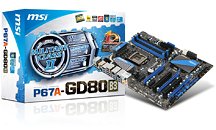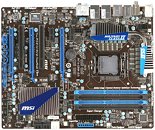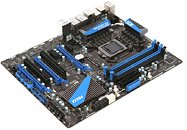Sunday, February 27th 2011

MSI Announces P67A-GD80 B3 Motherboard
World-renowned mainboard and graphics card manufacturer MSI has released the latest board to support Inte's Sandy Bridge processors and aimed towards enthusiasts: the P67A-GD80 (B3) mainboard. Utilizing MSI's various P67's exclusive specifications and technologies, such as the Military Class II Components standard which symbolizes high quality and stability, the comprehensive OC Genie II one-touch overclocking system, the uEFI-based ClickBIOS technology, and the SuperCharger function that provide mobile devices with the optimal charging. It also has a built in 12 phase DrMOS power supply and 3 sets of PCI-E x16 2.0 expansion slots, providing a more stable power supply for overclocking and for support up to a maximum of three-way multi-GPU computing.Military Class II Components - A Standard for Higher Quality
Continuing MSI's tradition for the P67/H67 series design, the all new P67A-GD80 (B3) is built with top-class second generation military standard materials and parts; through the benefits of Hi-c CAP, Super Ferrite Choke (SFC) and Solid CAP, the overall product lifespan has reached a higher level.
12 DrMOS Power Phase -- a Higher Level of Overclocking Stability
Satisfying the extreme enthusiasts' power supply needs for over-clocking, the P67A-GD80 (B3) uses a specially designed 12 phase power design, combined with MSI's leading DrMOS advanced digital VRM, it allows outstanding performances on both power supply quality and efficiency, effectively increasing system stability when pushing for extreme overclocking.
Three sets of PCI-E x16 2.0 - Higher 3D Performance
In order to make it easy for enthusiasts to increase their 3D display performance, the all new P67A-GD80 (B3) has three sets of PCI-E x16 2.0 expansion slots built in, and can support up to a maximum of three-way SLI or CrossFireX multi-GPU Computing. The optimized slot interval design allows you to avoid problems with dual slot graphics cards; this is one of P67A-GD80 (B3)'s design features to provide better airflow.
OC Genie II - Complete System Overhaul with the Touch of a Button
The widely popular OC Genie II overclocking technology for the P67/H67 series is also equipped on the P67A-GD80 (B3); by using the hardware buttons on the motherboard or options in the ClickBIOS interface, enthusiasts can achieve system optimization in the blink of an eye; there is no need for complex computer knowledge or performing any critical settings -- just activate the OC Genie II function to unleash all of the system's potential performances in a second.
Combined Software and Hardware Specifications for a Complete Experience
The all new P67A-GD80 (B3) continues MSI's rich functions and features for the P67 series, for including exclusive functions such Control Center II's Instant OC function that does not require restarting the system after overclocking in the operating system, SuperCharger technology which provides 3 times the charging power through front panel USB ports, and Hollywood-class THX sound field enhancement technology. It also supports 10 sets of USB3.0 and 4 sets of SATA 6Gbps connection ports, making it a top choice in terms of either expandability or convenience. This is a board that enthusiasts can't afford to miss when purchasing the P67 series products.
For more information, visit the product page.
Continuing MSI's tradition for the P67/H67 series design, the all new P67A-GD80 (B3) is built with top-class second generation military standard materials and parts; through the benefits of Hi-c CAP, Super Ferrite Choke (SFC) and Solid CAP, the overall product lifespan has reached a higher level.
12 DrMOS Power Phase -- a Higher Level of Overclocking Stability
Satisfying the extreme enthusiasts' power supply needs for over-clocking, the P67A-GD80 (B3) uses a specially designed 12 phase power design, combined with MSI's leading DrMOS advanced digital VRM, it allows outstanding performances on both power supply quality and efficiency, effectively increasing system stability when pushing for extreme overclocking.
Three sets of PCI-E x16 2.0 - Higher 3D Performance
In order to make it easy for enthusiasts to increase their 3D display performance, the all new P67A-GD80 (B3) has three sets of PCI-E x16 2.0 expansion slots built in, and can support up to a maximum of three-way SLI or CrossFireX multi-GPU Computing. The optimized slot interval design allows you to avoid problems with dual slot graphics cards; this is one of P67A-GD80 (B3)'s design features to provide better airflow.
OC Genie II - Complete System Overhaul with the Touch of a Button
The widely popular OC Genie II overclocking technology for the P67/H67 series is also equipped on the P67A-GD80 (B3); by using the hardware buttons on the motherboard or options in the ClickBIOS interface, enthusiasts can achieve system optimization in the blink of an eye; there is no need for complex computer knowledge or performing any critical settings -- just activate the OC Genie II function to unleash all of the system's potential performances in a second.
Combined Software and Hardware Specifications for a Complete Experience
The all new P67A-GD80 (B3) continues MSI's rich functions and features for the P67 series, for including exclusive functions such Control Center II's Instant OC function that does not require restarting the system after overclocking in the operating system, SuperCharger technology which provides 3 times the charging power through front panel USB ports, and Hollywood-class THX sound field enhancement technology. It also supports 10 sets of USB3.0 and 4 sets of SATA 6Gbps connection ports, making it a top choice in terms of either expandability or convenience. This is a board that enthusiasts can't afford to miss when purchasing the P67 series products.
For more information, visit the product page.



10 Comments on MSI Announces P67A-GD80 B3 Motherboard
Without that they haven't said much,....
Have been looking at the Asus Maximus IV Extreme but the 16X slot setup for SLI leaves a lot to be desired, the Asus P8P67 WS Revolution on the other hand has and ideal slot distribution for SLI setups leaving enough breathing room between both electric 16X slots, but is missing a lot of the features found on the ROG model.
This MSI board looks well balanced, I think it has the N200 to handle 16X triple SLI if I'm not mistaken, and the price (around $260 according to a Google search) is very tempting.
I've never had any experience with MSI boards, can you guys provide any feedback on how these boards compare to the likes of Asus and Gigabyte (my two favorite board manufacturers), are they good for OCing? How about the quality of the board? Any of you guys had any experience with MSI's support?
My UD7 is a great OCer, I can reach 5.2Ghz stable, but I'm tired of the extremely finicky dual BIOS feature, that activates on any minor crash, and I'm also wary of how GB handled the whole P67 debacle, not offering any direct exchange or advanced shipment of a new B3 board to keep downtime to the minimum. To me it's like GB just looked the other way and let retailers handle all the trouble. It took me forever to get an RMA from Provantage for my board, and that left a bad taste in my mouth, so GB is not an option for me anymore.
What do you guys think about Asus and MSI P67 boards? Any input will be greatly appreciated. :)
To get to 5.2Ghz stable I had to re-flash my BIOS at least 6 times as every time I would push my OC too high and crash while running prime95, IBT or 3dMark, this board has the nasty habit of restoring your BIOS to the factory default, erasing all your settings and even settings that are not available on the F3 release. :shadedshu
Back to topic, just checked and none of MSI's P67 boards have a NF200 chip in them, leaving you with only PCIe 8x or worse on SLI or Crossfire, I know 16x doesn't make that much of a difference, but due to P67 limitations you also have to share your PCIe bandwidth with USB, HDDs, and other components, crippling performance on a multiple video card setup.
Looks like the most sensible option left is the Asus P8P67 WS Revolution, due to its great 16x slot placing, not even the UD7 or the Maximus IV can match its design.